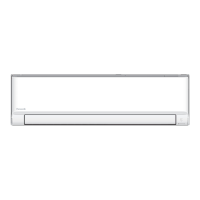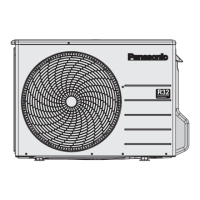83
13. Installation and Servicing Air Conditioner using R32
13.1 About R32 Refrigerant
For air conditioning refrigerants such as R410A, the refrigerants were collected back in order to prevent their air
dissipation, to curbe the global warming impact, in case they were released into the atmosphere. In the “4th
Environmental Basic Plan”, 80% reduction of greenhouse gas emissions by 2050 is required, and due to this
requirement, further reduction in the emission of high greenhouse effect gas, such as CFCs, is required. Therefore,
the conversion of air conditioning refrigerant into the ones who has smaller greenhouse effect, even if it is dissipated
into the atmosphere, became our responsibility.
Nevertheless, in case of air conditioning refrigerant, it would be the best if there is a refrigerant which has smaller
impact on global warming, but ensures good energy efficiency and performance, and is safe; however, there is no
such refrigerant which satisfies all these conditions. As a result, we have been considering the practical usage, within
the safety frame-work, of R32 refrigerant which has short lifetime in the atmosphere, and has smaller effect of global
warming, but is slightly flammable.
In 2004, due to the revision of air conditioner safety standards by the International Electro-safety Commission (IEC),
the safety standards of air conditioners using slightly flammable refrigerant was issued. In 2010, the regulations of
American Society of Heating, Refrigerating and Air-Conditioning Engineers in the United States (ANSI/ASHRAE34)
was issued adopting the grades for refrigerants which are difficult to inflame due to their slow burning rates, and as a
result have smaller damages in cases of fire. The burning rate of R32 is lower by 10cm / per second, and safety
standardization for various usage is now being processed.
13.2 Characteristics of R32 Refrigerant
1. Chemical Characteristics
R32 is one of the refrigerants used in R410A, has almost no toxicity, and chemically stable compound formed by
hydrogen, carbon and fluorine.
R32 has short lifetime of 4 to 9 years in case of being released into the atmosphere; therefore, it has smaller
greenhouse gas effect but has slight inflammability because of the large proportion of hydrogen.
Chemical Characteristic Table of R32, R410A and R22.
R32 R410A R22
Chemical Formula CH2F2 CH2F2 / CHF2CF3 CHCLF2
Composition
(mixture ratio wt.%)
Single Composition
R32 / R125A
Single Composition
(50 / 50 wt.%)
Boiling Point (°C) -51.7 -51.5 -40.8
Pressure (physical) *1 3.14 3.07 1.94
Capacity (physical) *2 160 141 100
COP (physical) *3 95 91 100
Ozone Depletion Potential (ODP) 0 0 0.055
Global Warming Potential
(GWP) *4
675 2090 1810
Inflammability *5
Slightly Inflammable
(A2L)
Non-inflammable (A1) Non-inflammable (A1)
Toxicity None None None
*1:Physical property of temperature condition 50°C
*2:Relative value of temperature condition 0/50°C, providing R22=100
*3:Te/Tc/SC/SH=5/50/3/0°C
*4:GWP=Global Warming Potential, each figure is based on “4
th
IPCC4 Report”
*5:Based on ANSI / ASHRAE std. 34-2010

